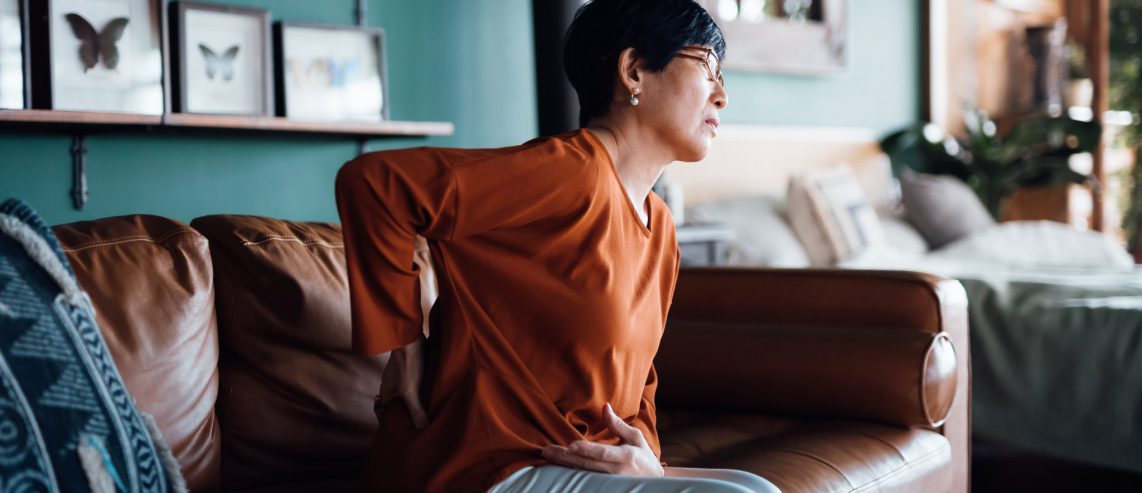If you’ve ever asked, “Is back pain normal?” the answer is yes. In fact, back pain is common. About eight in 10 people will have back pain at some point during their lives.
But knowing back pain is common brings little comfort when you’re the one in pain. It can feel anything but normal. Severe pain can make even the smallest movements feel excruciating.
Most back pain goes away on its own, improving over the course of several days. But some people have chronic back pain. This is pain that lasts for more than three months.
Every year, people experiencing back pain visit emergency rooms, primary care doctors, and spine specialists.
There are a range of treatments. Many people find relief taking non-narcotic pain medicine and working with physical therapists. A small percentage wind up having surgery.
But what causes back pain to begin with?
Why Does My Lower Back Hurt All of a Sudden?
Some back pain comes on slowly, like a dull ache that gets worse over time. But acute back pain is pain that comes on suddenly, often without warning. People sometimes describe it as their back “locking up.”
Muscle strain and muscle spasm are two common causes of acute low back pain. You can strain a muscle by moving in ways you don’t usually move. Lifting something heavy is one of the most common causes.
But sometimes you can strain a muscle doing familiar activities, like reaching to pull off shoes. You may not even know what you did to cause the pain. Doing the same movement over and over can also cause pain over time.
There are some common risk factors for low back pain. These include:
- Your job: Interestingly, jobs that involve sitting at a desk all day can cause as many back problems as jobs that require heavy lifting. The common thread between both is poor posture. If you lift using improper technique, or sit hunched or without proper back support, you’re at risk.
- Your age: The typical age for the first episode of low back pain is between 30 and 50. Unfortunately, the older you are, the more common back pain is. As you get older, your spinal canal gets narrower (spinal stenosis) and can squeeze the nerves, causing pain.
- Your overall fitness level: Athletes and active people have their share of low back pain. But people who aren’t as physically fit are at greater risk. This is because they may lack core strength to help support the spine.
- Your genes: Some conditions that cause back pain, like certain forms of arthritis, have a genetic component.
- Smoking: Smoking is an often-overlooked risk factor for low back pain. Smoking has many ill health effects, including restricting blood flow and oxygen. If the discs that cushion your spine don’t get enough blood and oxygen, they start to wear out sooner.
- Your mental health: We know that mind and body are linked. Depression and anxiety can worsen back pain. Stress, because it causes muscle tension, can also make back pain worse.
Never Miss a Beat!
Subscribe to Our HealthBeat Newsletter!
Thank you for subscribing!
You can now select the specific newsletters you'd like to receive.
You are already subscribed.
Subscribe to more newsletters in our email preference center.
Sorry, an error occurred. Please try again later.
Get Healthy Tips Sent to Your Phone!
When Should I Call a Doctor If I Have Back Pain?
Most acute back pain will go away on its own. However, it may take a long time. As long as the pain continues to improve each day, it’s a good sign.
Call your doctor if:
- You’ve sustained an injury (such as a fall or a car accident) and are in severe pain.
- Your pain doesn’t improve after three days.
- You also have new leakage of urine or stool, inability to pass urine, weakness, numbness, or new problems with your manner of walking.
How Can I Treat Back Pain?
At home, you can take over-the-counter medicine to reduce pain and inflammation. This can include ibuprofen, naproxen, acetominophen, or aspirin.
You can also use ice packs at home, to help with swelling and inflammation. Alternating between cold and heat can help as well. Heat increases blood flow and helps muscles and tissues heal faster.
Do your best to avoid lying in bed all day. While you should limit activities and exercises that hurt, moving around can help. Many people make the mistake of immobilizing their back, which can make pain worse.
Your doctor may prescribe:
- Muscle relaxing medicines.
- Pain relieving or numbing injections.
- Physical therapy to help increase mobility and strengthen the muscles around the back.
Your doctor may also refer you to a spine specialist if they suspect you have a more serious injury.
Can I Do Anything to Prevent Back Pain?
You can seemingly do everything right and still have episodes of acute low back pain. But there are some good practices that may lower your risk.
- Exercise: Getting regular exercise helps keep the muscles of your spine strong and flexible. Core strength classes like yoga and Pilates specifically target spinal muscles. Weight training can also help, particularly exercises like squats and deadlifts (always keep proper form).
- Taking standing/walking breaks: If you have a sedentary job, set your watch or phone alarm to go off every 30 minutes. Each time, get up and take a short walk, even if it’s just around the office or your house.
- Wear comfortable shoes: Shoes with high heels can cause back problems, because they put your foot at an angle. This pulls your muscles out of alignment. Consider wearing low-heeled shoes on days you’ll be on your feet a lot.
- Use proper form when lifting things: Squat down, with your back straight, and lift from the knees. Use the muscles in your legs to lift and keep the object close to your body.
- Quit smoking: There are so many positives to quitting smoking. Reducing your risk for back pain is yet another. Because it reduces blood flow, smoking is linked to disc degeneration and poor healing.
- Maintain a healthy weight: Talk to your doctor about what a healthy weight is for you. Extra weight can strain the muscles and ligaments of your back.
See more answers to common questions about back pain.
Ultimately, if you have back pain that persists, don’t wait to see someone. You can start with a primary care doctor, who may refer you to a specialist.
Editor's Note: This article was originally published on , and was last reviewed on .
Sources
About UPMC
Headquartered in Pittsburgh, UPMC is a world-renowned health care provider and insurer. We operate 40 hospitals and 800 doctors’ offices and outpatient centers, with locations throughout Pennsylvania, Maryland, New York, West Virginia, and internationally. We employ 4,900 physicians, and we are leaders in clinical care, groundbreaking research, and treatment breakthroughs. U.S. News & World Report consistently ranks UPMC Presbyterian Shadyside as one of the nation’s best hospitals in many specialties and ranks UPMC Children’s Hospital of Pittsburgh on its Honor Roll of America’s Best Children’s Hospitals. We are dedicated to providing Life Changing Medicine to our communities.

